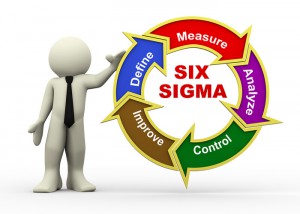Which Six Sigma Certification Is Right for You?
Are you looking for a way to increase the value that you add to your company? Are you interested in career advancement that can bring position promotion and a higher salary? Consider becoming certified as a Six Sigma professional.
 Six Sigma methodology has proved its worth in industries ranging from healthcare, financial services, manufacturing and even government administration. Organizations that use Six Sigma can improve customer satisfaction, increase productivity and enhance financial performance.
Six Sigma methodology has proved its worth in industries ranging from healthcare, financial services, manufacturing and even government administration. Organizations that use Six Sigma can improve customer satisfaction, increase productivity and enhance financial performance.
Employees with a Six Sigma certification can help their companies obtain these benefits while they create a promising future for themselves.
How to Choose the Right Six Sigma Certification?
Six Sigma certifications are based on a belt system. Like the martial arts, Six Sigma offers different certifications at different levels. Each certification is suited to the employee’s training, level of expertise and time spent to working on projects.
Below we’ll discuss, from lower level to higher level, the Green Belt, Black Belt and Master Black Belt Six Sigma certifications.
Six Sigma Green Belt – This is for part-time Six Sigma practitioners. Green Belts typically spend about 25% of their time contributing to Six Sigma projects and the remainder working in other areas. Green Belts are highly valued for the functional knowledge they bring to the project team. They are not only experts in Six Sigma, but also experts in the process that they are improving. Green Belts help their project teams gather and analyze data, and play an important role in identifying and implementing improvements.
In addition to classroom training, Green Belts have acquired the following practical skills and real-world experience.
- Possess a basic knowledge of statistical analysis
- Contribute to quality improvement projects
- Work cooperatively with other project team members
- Analyze and solve quality problems
- Understand and apply Six Sigma tools
Six Sigma Black Belt – Black Belts lead project teams and act as mentors to individual team members. Six Sigma is their primary responsibility and they practice it full time. Qualifications for a Black Belt role include three years of relevant work experience and completion of two Six Sigma projects.
Successful Black Belts are able to do the following:
- Apply leadership and administrative skills. Black Belts use time management, decision-making and planning tools to keep their teams on schedule. They also use team building, performance evaluation and reward and incentive programs to motivate and encourage team members.
- Anticipate resistance and use change management techniques to overcome it and ensure that Six Sigma improvements are put into practice.
- Understand how Six Sigma and related philosophies, such as such as Lean, continuous process improvement and Total Quality Management complement each other and work together to improve financial performance.
- See a Six Sigma project and its deliverables in terms of their impact on the customer.
- Use benchmarking and understand how to apply business performance measures.
Six Sigma Master Black Belt (MBB) – Master Black Belts are the highest Six Sigma belt. They act as liaisons with upper management. MBBs are technical experts and Six Sigma authorities who coach, teach and mentor both project teams and corporate executives in the ways of Six Sigma.
Master Black Belts must complete 10 Six Sigma projects or have five years of Black Belt experience to be considered for certification.
Which certification is right for you?
